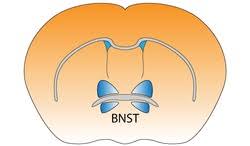In the 1990s, researchers identified a tiny structure that played a key role in how rodents dealt with "ambiguous threats"—ones that didn't place them in immediate danger. Called the Bed Nucleus of the Stria Terminalis (BNST), it was about the size of a sunflower seed and located near the amygdala. While the amygdala appears to be the brain area primarily involved in activating the fight-or-flight response, the BNST kicks in when we have reason to remain hypervigilant—that hormone-driven state of hyperarousal we feel in our bodies when we are tense in the face of uncertainty.

In a neuroimaging lab at the University of Louisville, Brendan E. Depue, a psychology professor, has shown how these findings in rodents manifest in humans. Placing students one by one in an fMRI machine, Depue simulated fear conditions by showing subjects images of fearful faces and playing them sounds of human screams. To simulate ambiguous threats, he simply projected a blank screen and informed subjects that a scream or fearful face could occur at any time, but the subject might also at any time be shown a neutral face and hear indistinct coffee shop chatter instead. Under these conditions, the amygdala consistently activated when the screams and scared faces appeared and the BNST was more engaged with the ambiguous threats.












